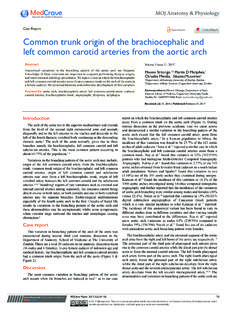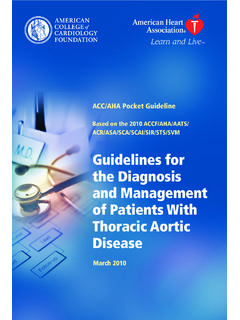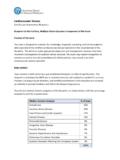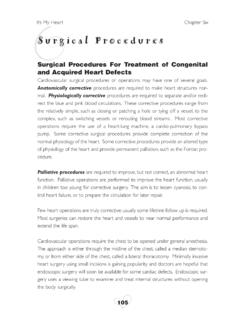Transcription of POSTOPERATIVE AIRWAY COMPLICATIONS AFTER CLEFT …
1 Sign up to receive ATOTW weekly - email ATOTW 237 POSTOPERATIVE AIRWAY COMPLICATIONS AFTER CLEFT palate repair , 22/08/2011 Page 1 of 11 POSTOPERATIVE AIRWAY COMPLICATIONS AFTER CLEFT PALATE REPAIR ANAESTHESIA TUTORIAL OF THE WEEK 237 22ND AUGUST 2011 Dr Ellen Rawlinson Great Ormond Street Hospital NHS Trust, London Correspondence to QUESTIONS Before continuing, try to answer the following questions. The answers can be found at the end of the article, together with an explanation. 1. The aetiology of AIRWAY obstruction following CLEFT palate repair may include: a. Laryngospasm b. Newly repaired palate contacting the posterior pharyngeal wall c. Retained throat pack d. Bleeding and blood clots in the AIRWAY e. Respiratory depression due to opioid use 2.
2 In children undergoing CP repair: a. AIRWAY obstruction is more common in children with micrognathia b. Syndromes that do not affect the AIRWAY do not increase the risk of POSTOPERATIVE AIRWAY obstruction c. AIRWAY obstruction is most likely to occur in the immediate POSTOPERATIVE period d. There is good evidence that dexamethasone reduces the incidence of POSTOPERATIVE AIRWAY obstruction e. The tongue gag should be released every 90 minutes to reduce the risk of significant tongue swelling 3. Nasopharyngeal airways (NPA) in children following CP repair: a. May be constructed from standard uncuffed endotracheal tubes b. Should not be inserted until AIRWAY obstruction becomes problematic c. Should be placed so the tip lies beyond the epiglottis d.
3 Require higher levels of POSTOPERATIVE observation than children without NPAs e. Require regular suctioning to maintain patency 4. In the POSTOPERATIVE period: a. If AIRWAY obstruction occurs positioning the child lateral or prone may be sufficient b. Oropharyngeal airways are contraindicated due to the risk of damaging the surgical repair c. If re-intubation is required it is unlikely to be more difficult than for the original procedure d. Oxygen therapy is mandatory for all children in the first 24 hours following surgery e. Appropriate observation includes an apnoea monitor if the child is less than 12 months old INTRODUCTION CLEFT lip and palate (CLP) is one of the commonest congenital abnormalities, with an incidence of 1 in 700 - 800 live births.
4 The abnormality causes feeding, speech and orthodontic problems and the psychosocial effects can be significant. Surgical repair is not without challenge but may be achieved successfully even in settings with limited resources. An overview of anaesthetic considerations pertinent to CLP repair has been described in ATOTW 72 [1]. AIRWAY COMPLICATIONS , including AIRWAY obstruction are the most significant POSTOPERATIVE concerns. This article will focus on the aetiology and Sign up to receive ATOTW weekly - email ATOTW 237 POSTOPERATIVE AIRWAY COMPLICATIONS AFTER CLEFT palate repair , 22/08/2011 Page 2 of 11 risk factors for AIRWAY COMPLICATIONS AFTER CLEFT palate (CP) repair and address ways in which they may be prevented or managed. AETIOLOGY OF AIRWAY COMPLICATIONS AFTER CLEFT PALATE REPAIR AIRWAY COMPLICATIONS AFTER CP repair range from episodes of mild stertor (noisy, snoring-like breathing resulting from obstruction in the naso- or oropharynx) to complete loss of the AIRWAY requiring re-intubation.
5 AIRWAY COMPLICATIONS may occur in the immediate POSTOPERATIVE period, or on the ward postoperatively. It is useful to consider the aetiology of AIRWAY obstruction, although in reality, the cause may be multifactorial. Congenital abnormalities associated with micrognathia: Surgery for CP repair aims not only to close the defect but also to reconstruct the soft palate musculature to promote better speech development. Obstruction may occur postoperatively particularly in young infants who are obligate nasal breathers, as the tongue falls back and the newly repaired palate rests against the posterior pharyngeal wall. This is more likely to occur in children who have a small mandible (micrognathia), and limited space in the oral cavity to accommodate the tongue (see congenital syndromes below).
6 Anaesthetic or surgical COMPLICATIONS : Retained throat pack Bleeding or blood clots in the AIRWAY Laryngospasm Reduction in pharyngeal tone due to the residual effects of volatile agents Respiratory depression due to opioid analgesia Laryngeal oedema secondary to difficult intubation Tongue oedema secondary to prolonged insertion of the mouth gag RISK FACTORS FOR AIRWAY COMPLICATIONS AFTER CLEFT PALATE SURGERY Syndromes and congenital abnormalities The risk of POSTOPERATIVE AIRWAY obstruction AFTER CLEFT palate repair is increased in the presence of a named syndrome or other congenital anomaly, even if these do not specifically affect the AIRWAY . The overall incidence of POSTOPERATIVE AIRWAY obstruction AFTER CP repair is around 6% in all patients; the incidence rises to 25% in children who have a congenital abnormality of any type.
7 AIRWAY difficulties at the time of CP repair are particularly common in children with micrognathia and are predicted by: AIRWAY difficulties AFTER birth, including respiratory problems, feeding difficulties, aspiration and apnoeas AIRWAY intervention required in the first few weeks or months of life, including lateral or prone positioning, nasopharyngeal AIRWAY , tongue-lip adhesion, or in the most severe cases, tracheostomy. This remains true even if the AIRWAY appears to be relatively normal at the time of surgery. These children may be compensating well for a minor degree of micrognathia, but AIRWAY compromise becomes apparent postoperatively AFTER CLEFT repair. Sign up to receive ATOTW weekly - email ATOTW 237 POSTOPERATIVE AIRWAY COMPLICATIONS AFTER CLEFT palate repair , 22/08/2011 Page 3 of 11 Common syndromes and congenital abnormalities associated with AIRWAY problems.
8 Pierre Robin Sequence Pierre Robin sequence (PRS) describes the clinical triad of micrognathia, retroglossoptosis and CLEFT palate. It is thought to be due to mandibular hypoplasia during early development; the tongue is pushed back high into the oral cavity and prevents closure of the palatal shelves, resulting in the typical, wide, U-shaped CLEFT palate seen in over 90% of patients. Micrognathia is seen in the majority of patients and is most noticeable in early infancy; catch up growth occurs so that by 5-6 years of age, most non-syndromic children have a normal mandibular size [2]. PRS may be an isolated anomaly (50% of patients) or found as part of another syndrome, such as velocardiofacial syndrome (7%), Stickler syndrome (20%) or Treacher Collins syndrome (5%).
9 Velocardiofacial syndrome Velocardiofacial syndrome (VCF) is a genetic syndrome associated with a wide spectrum of clinical features. Cardiac anomalies are seen in 75% of cases (typically conotruncal abnormalities such as interrupted aortic arch, truncus arteriosus, tetralogy of Fallot), thymic abnormalities (impaired immune function) and parathyroid abnormalities (hypocalcaemia). 10% of cases with VCF have Di George syndrome (conotruncal abnormality, hypoarathyroidism, hypocalcaemia, immune deficiency). Patients have unique facial characteristics, mild developmental delay and psychiatric disorders. The palatal abnormality may be a submucous CLEFT associated with hypernasal speech, or overt CLEFT palate. 15-20% of patients with VCF have Pierre Robin sequence [3].
10 Stickler syndrome Stickler syndrome is also known as hereditary arthro opthalmopathy. It describes a group of collagen disorders associated typical facial features (flat face, small nose, flat nasal bridge), CLEFT palate and eye abnormalities (high myopia, glaucoma, retinal detachment, cataract), hearing or joint problems (hypermobility, arthritis). Treacher Collins syndrome This is an autosomal dominant syndrome with variable penetrance and clinical severity, associated with CLEFT palate and bilateral mandibular and maxillary hypoplasia, with typical beaked nose, ear abnormalities and eye abnormalities (anti mongoloid slant, colobomas of the lower lids, absent eyelashes) CHARGE association This is an autosomal dominant condition associated with CLEFT palate (30-50% of patients), dysmorphic features and a non-random association of Coloboma, Heart defect, Atresia choanae, Retarded growth and development, and/or CNS anomalies, Genital hypoplasia, and Ear anomalies and/or deafness.

















